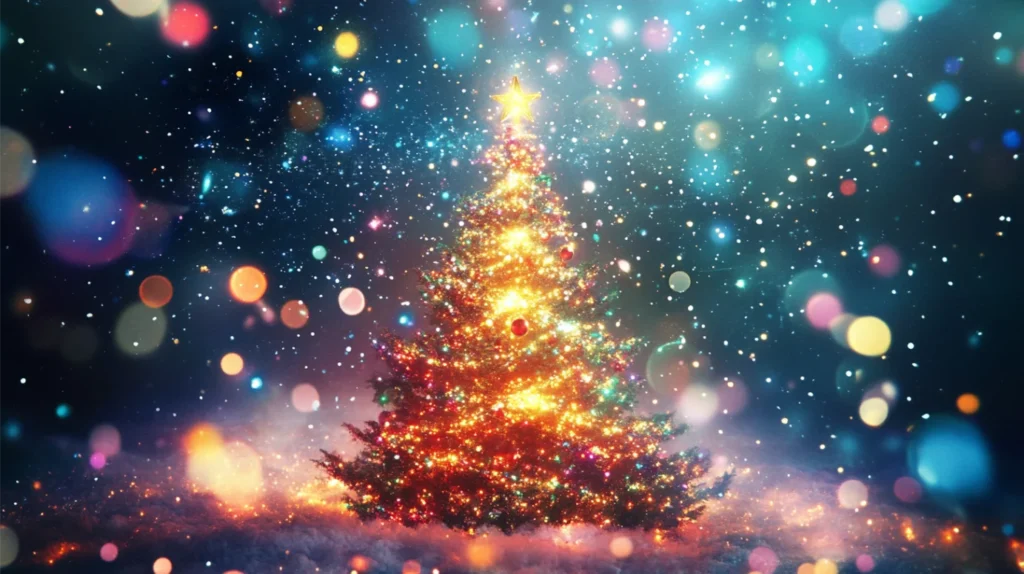
The Christmas tree stands tall and proud in homes around the world during the holiday season, its twinkling lights and shimmering ornaments a beacon of cheer. But have you ever paused to consider the deeper spiritual significance of this beloved tradition? Beyond its festive appearance, the Christmas tree holds a wealth of meaning that connects us to nature, faith, and the spirit of the season.
As we gather around the tree each year, we’re not just decorating our homes – we’re participating in a ritual that stretches back centuries. The Christmas tree has become a powerful symbol, one that speaks to our hearts and souls in ways we might not even realize. Let’s explore the rich spiritual tapestry woven into every branch and bauble of this holiday icon.
Key Takeaways:
- The Christmas tree symbolizes eternal life and hope
- Its evergreen nature represents resilience and renewal
- Decorations and lights carry spiritual meanings of their own
- The tree connects us to nature and ancient traditions
- It serves as a focal point for family, community, and reflection
The Roots of Tradition: Where Did Christmas Trees Come From?

The story of the Christmas tree begins long before Christianity. Ancient cultures revered evergreen plants for their ability to stay green throughout the harsh winter months. These steadfast trees were seen as powerful symbols of life, hope, and resilience in the face of adversity.
As Christianity spread across Europe, these pagan traditions were often adapted and given new meaning. The Christmas tree as we know it today began to take shape in 16th century Germany. Legend has it that Protestant reformer Martin Luther was inspired by the sight of stars twinkling through evergreen trees on a winter’s night. He recreated the scene for his family by bringing a small tree indoors and decorating it with candles.
From these humble beginnings, the tradition grew and evolved. By the 19th century, Christmas trees had become popular throughout Europe and were introduced to America by German immigrants. Today, they’re a beloved part of holiday celebrations around the world.
Evergreen Symbolism: A Message of Hope and Renewal
At its core, the spiritual meaning of a Christmas tree is deeply rooted in its evergreen nature. Unlike deciduous trees that lose their leaves in winter, evergreens remain vibrant and alive even in the coldest months. This remarkable quality has long been associated with eternal life, hope, and the promise of renewal.
In the Christian tradition, this symbolism takes on added significance. The evergreen tree reminds believers of the everlasting life offered through faith. Its triangular shape points heavenward, directing our thoughts and prayers upward. The tree becomes a living representation of God’s unchanging love and the hope found in the Christmas story.
But you don’t have to be religious to appreciate the powerful message of the evergreen. Its resilience in the face of winter’s challenges can inspire us all. What aspects of your life remain “evergreen” even during difficult times? How can you cultivate that kind of inner strength and hope?
Illuminating the Darkness: The Spiritual Significance of Christmas Lights

One of the most enchanting aspects of a Christmas tree is the way it glows with light. Whether adorned with traditional candles or modern electric strings, these twinkling lights carry deep spiritual meaning.
Light has long been a powerful symbol in spiritual traditions around the world. It represents:
- Knowledge and wisdom
- Divine presence and guidance
- Hope in times of darkness
- The triumph of good over evil
When we illuminate our Christmas trees, we’re participating in this ancient symbolism. The lights remind us to be beacons of hope and kindness in the world. They encourage us to seek enlightenment and to share our inner light with others.
Think about how the glow of a Christmas tree makes you feel. Does it bring a sense of peace, wonder, or joy? How can you carry that light with you throughout the year?
Ornaments and Decorations: More Than Meets the Eye
The baubles, garlands, and other decorations we hang on our Christmas trees aren’t just for show. Many of these adornments carry their own spiritual significance:
- Apples: Representing the forbidden fruit in the Garden of Eden
- Stars: Symbolizing the Star of Bethlehem that guided the Wise Men
- Angels: Messengers of God and guardians
- Tinsel: Representing the light of the stars or divine light
- Candy canes: Often said to represent the shepherd’s staff
Even the act of decorating the tree can be spiritually meaningful. It’s a time for family and friends to come together, sharing memories and creating new ones. The ornaments themselves often carry sentimental value, connecting us to loved ones past and present.
As you decorate your tree this year, take a moment to reflect on the meaning behind each ornament. What stories do they tell? What values do they represent?
A Bridge to Nature: The Tree as a Connection to the Earth
In our increasingly urban and digital world, the Christmas tree provides a much-needed connection to nature. Bringing a living tree (or even an artificial representation of one) into our homes reminds us of our place in the natural world.
This connection to nature has deep spiritual significance. Many traditions emphasize the importance of harmony with the earth and respect for the natural world. The Christmas tree can serve as a reminder of these values, encouraging us to be good stewards of the environment.
The tree also represents the cycle of life, death, and rebirth. Even as we cut down trees for the holiday, we’re reminded of the importance of renewal and sustainability. Many modern Christmas tree farms practice responsible forestry, planting multiple trees for each one harvested.
How does having a tree in your home change your relationship with nature? Does it inspire you to spend more time outdoors or to be more mindful of your environmental impact?
A Focal Point for Reflection and Gratitude
Perhaps one of the most powerful spiritual aspects of the Christmas tree is its ability to serve as a focal point for reflection and gratitude. As we gather around the tree to exchange gifts or simply enjoy its beauty, we’re reminded of the blessings in our lives.
The tree can become a kind of altar, a sacred space within our homes where we can pause and connect with something greater than ourselves. It’s a place to:
- Reflect on the past year
- Express gratitude for our blessings
- Set intentions for the future
- Connect with loved ones
- Find moments of peace and stillness
In the hustle and bustle of the holiday season, the Christmas tree offers a visual reminder to slow down and appreciate the present moment. Its quiet presence can be deeply grounding and centering.
Christmas Trees Around the World
The spiritual significance of Christmas trees isn’t limited to one culture or tradition. Let’s explore how different parts of the world incorporate trees into their holiday celebrations:
| Country | Tree Tradition | Spiritual Significance |
|---|---|---|
| Germany | Tannenbaum | Represents paradise tree from Eden |
| Mexico | Nacimiento scenes | Focus on nativity, with small tree as backdrop |
| Japan | Kurisumasu Tsuri | Adopted tradition, symbol of Western culture and globalization |
| Ukraine | Spider web decorations | Legend of spider webs turning to silver, represents good fortune |
| India | Mango or Banana trees | Adaptation of tradition using local plants |
These diverse traditions show how the spiritual meaning of the Christmas tree can be adapted and interpreted in different cultural contexts. No matter where you are in the world, the tree serves as a symbol of hope, renewal, and community.
Nurturing the Spirit: Caring for Your Christmas Tree
The act of caring for a Christmas tree can itself be a spiritual practice. Whether you have a live tree or an artificial one, the attention and care you give it can be a form of meditation and mindfulness.
For live trees:
- Watering the tree daily becomes a ritual of nurturing and sustaining life
- Sweeping up fallen needles reminds us of the impermanence of all things
- The scent of pine can be used as a focus for mindful breathing
For artificial trees:
- The annual tradition of assembling the tree becomes a practice in patience and creativity
- Carefully storing ornaments preserves memories and connections to the past
- Reusing the same tree year after year can represent constancy and tradition in our lives
As you care for your tree this season, consider how these small acts can become meaningful rituals. How can you bring more mindfulness to your holiday preparations?
Conclusion: The Living Spirit of the Christmas Tree
As we’ve explored, the Christmas tree is far more than just a holiday decoration. It’s a living symbol, rich with spiritual meaning and significance. From its evergreen branches to its twinkling lights, every aspect of the tree speaks to something deeper in the human spirit.
This holiday season, take a moment to really see your Christmas tree. Let it remind you of hope, renewal, and the interconnectedness of all things. Allow its presence to ground you in the present moment and connect you to timeless traditions. And most importantly, let it fill your heart with the joy and wonder of the season.





